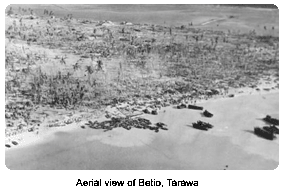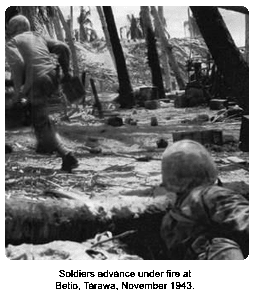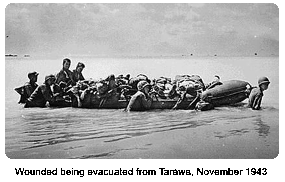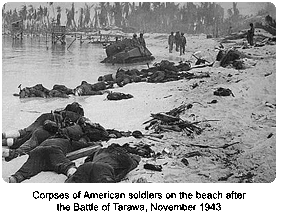The islet group of Tarawa, about 2,400 miles southwest of Hawaii, was held by the Japanese from 1941 to 1943 during World War II, and it fell to U.S. Marines of the Second Division after a bloody 76-hour battle. Tarawa`s military significance lay in its strategic position as the entrance of the U.S. push through the central Pacific to the Philippine Islands.
 The Battle of Tarawa was partly a product of poor U.S. planning, a battle in which marines waded endlessly to shore — at low tide — over razor-sharp coral under withering firepower. Marines also tried to avoid Japanese sniper fire by disembarking from assault boats farther from shore, and some drowned in the deeper water from the weight of their ammunition belts.
On November 20, U.S. battleships and destroyers staged a major artillery assault on the Tarawa islet of Betio, which was about three miles long and a half mile across. The islet was a tough Japanese fortification of pillboxes, bunkers, and Barbed Wire protecting an airfield, occupied by the main concentration of their forces, numbering 4,700 soldiers and construction workers.
Just after 5 a.m., the first shot at the Betio coast was fired from the American ships. The following salvos were so powerful that they caused explosions that lit up the sky. Marines gathered on the decks to watch the fireworks along the shoreline. There was so much rapid firepower from the ships that it looked to some like a machine-gun burst.
The Battle of Tarawa was partly a product of poor U.S. planning, a battle in which marines waded endlessly to shore — at low tide — over razor-sharp coral under withering firepower. Marines also tried to avoid Japanese sniper fire by disembarking from assault boats farther from shore, and some drowned in the deeper water from the weight of their ammunition belts.
On November 20, U.S. battleships and destroyers staged a major artillery assault on the Tarawa islet of Betio, which was about three miles long and a half mile across. The islet was a tough Japanese fortification of pillboxes, bunkers, and Barbed Wire protecting an airfield, occupied by the main concentration of their forces, numbering 4,700 soldiers and construction workers.
Just after 5 a.m., the first shot at the Betio coast was fired from the American ships. The following salvos were so powerful that they caused explosions that lit up the sky. Marines gathered on the decks to watch the fireworks along the shoreline. There was so much rapid firepower from the ships that it looked to some like a machine-gun burst.
 After the marines witnessed the hail of fire, many concluded that little could be left of the enemy. Next, they heard a roar in the air and saw dozens of torpedo bombers, dive bombers, and fighters called in to stage another attack, which drew no discernible resistance from the ground.
As the Higgens landing craft made their way in, they came to an abrupt halt on a reef. They had made the mistake of coming in on low tide. The reef was 500 yards from the shore and as soon as they hit it, the Japanese hit them with massive fire power, destroying many of the craft before the men could even disembark. The marines quickly realized that the enemy had not been neutralized. As the first wave of marines waded through the water to the beach, only a few managed to get to the shore.
After realizing that the Japanese had a larger force than anticipated, the Americans sent out more and more men in an effort to establish a beachhead. With those reinforcements, they managed to secure part of the beach only 100 yards long and 20 feet in from the water`s edge.
Meanwhile, the Japanese had lost their communications, but they were indoctrinated to either fight in place to the death, or commit suicide. With that determination, they fought fiercely against the Americans.
The Japanese dispatched a seaplane, equipped with bombs under the wings, to attack the assaught craft caught on the reef. That single aircraft became a great asset to the Japanese as it easily dropped bombs on the sitting ducks below, causing most of the damage.
After the marines witnessed the hail of fire, many concluded that little could be left of the enemy. Next, they heard a roar in the air and saw dozens of torpedo bombers, dive bombers, and fighters called in to stage another attack, which drew no discernible resistance from the ground.
As the Higgens landing craft made their way in, they came to an abrupt halt on a reef. They had made the mistake of coming in on low tide. The reef was 500 yards from the shore and as soon as they hit it, the Japanese hit them with massive fire power, destroying many of the craft before the men could even disembark. The marines quickly realized that the enemy had not been neutralized. As the first wave of marines waded through the water to the beach, only a few managed to get to the shore.
After realizing that the Japanese had a larger force than anticipated, the Americans sent out more and more men in an effort to establish a beachhead. With those reinforcements, they managed to secure part of the beach only 100 yards long and 20 feet in from the water`s edge.
Meanwhile, the Japanese had lost their communications, but they were indoctrinated to either fight in place to the death, or commit suicide. With that determination, they fought fiercely against the Americans.
The Japanese dispatched a seaplane, equipped with bombs under the wings, to attack the assaught craft caught on the reef. That single aircraft became a great asset to the Japanese as it easily dropped bombs on the sitting ducks below, causing most of the damage.
 At 6 a.m. on November 21, three marine battalions that were holding a small area of beach around a Betio lagoon were ordered to fire at the Japanese. That was to ease the attacks against the main wave of marines, to hinder the Japanese from slaughtering the men coming in through the water. Nevertheless, only 450 of the 800 men were able to make it to the shore. Those 450 men fought their way inland to the airbase, which they took over and from which they continued to fight.
As the morning tide began to rise, landing craft were able to pass over the reef and bring in many tanks. The tanks rolled onto the beach and fired directly at the pillboxes that had been giving the marines so much hell. By dusk, the Sixth Marine Regiment, after having taken the adjacent islet of Makin, paddled over the reef in rubber boats and landed on the western beach to combine with Major Ryan`s battered western lagoon assault battalion. He decided on a major assault against the Japanese.
The next day the major`s First Battalion and the Sixth Marines fought hard from the southern shore. They destroyed many of the remaining fortifications and wiped out numerous pillboxes. The main attacks for the remainder of the day were the enemy snipers and the remaining pill boxes that had given them so much trouble the day before.
That night the Japanese troops made one final attack on the Sixth Marines, Company B — a Banzai suicide charge. The marines were able to hold off the attack for a while, but when they radioed for reinforcements, they were told that they would not get them. The brave men were barely able to hold their positions against the charging waves of soldiers.
At 6 a.m. on November 21, three marine battalions that were holding a small area of beach around a Betio lagoon were ordered to fire at the Japanese. That was to ease the attacks against the main wave of marines, to hinder the Japanese from slaughtering the men coming in through the water. Nevertheless, only 450 of the 800 men were able to make it to the shore. Those 450 men fought their way inland to the airbase, which they took over and from which they continued to fight.
As the morning tide began to rise, landing craft were able to pass over the reef and bring in many tanks. The tanks rolled onto the beach and fired directly at the pillboxes that had been giving the marines so much hell. By dusk, the Sixth Marine Regiment, after having taken the adjacent islet of Makin, paddled over the reef in rubber boats and landed on the western beach to combine with Major Ryan`s battered western lagoon assault battalion. He decided on a major assault against the Japanese.
The next day the major`s First Battalion and the Sixth Marines fought hard from the southern shore. They destroyed many of the remaining fortifications and wiped out numerous pillboxes. The main attacks for the remainder of the day were the enemy snipers and the remaining pill boxes that had given them so much trouble the day before.
That night the Japanese troops made one final attack on the Sixth Marines, Company B — a Banzai suicide charge. The marines were able to hold off the attack for a while, but when they radioed for reinforcements, they were told that they would not get them. The brave men were barely able to hold their positions against the charging waves of soldiers.
 The counterattack on the night of the 22nd was the last-gasp effort of the Japanese on Betio island. The only men left to fight were scattered Japanese snipers and a few dazed and confused defenders. The battle was over after more than three days of hellish fighting.
The marines sustained nearly 3,000 casualties. The cost was much higher for the Japanese: Of the 4,700 defenders, only 17 survived. Their willingness to fight to the last man augured the nature of other battles to come.
The counterattack on the night of the 22nd was the last-gasp effort of the Japanese on Betio island. The only men left to fight were scattered Japanese snipers and a few dazed and confused defenders. The battle was over after more than three days of hellish fighting.
The marines sustained nearly 3,000 casualties. The cost was much higher for the Japanese: Of the 4,700 defenders, only 17 survived. Their willingness to fight to the last man augured the nature of other battles to come.